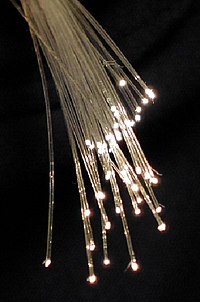
Photo from wikipedia
Laser cutting proves its suitability for cutting of single fiber-reinforced polymer (FRP) composites compared with conventional cutting techniques due to reduced fiber delamination, matrix cracking and fiber pullout. However, the… Click to show full abstract
Laser cutting proves its suitability for cutting of single fiber-reinforced polymer (FRP) composites compared with conventional cutting techniques due to reduced fiber delamination, matrix cracking and fiber pullout. However, the performance of the laser cutting process of hybrid FRP composites is yet to be revealed, which paves the way of the present study. In this article, an experimental investigation of the laser cutting process is carried out on 1.35-mm-thick Kevlar-29 and basalt fiber-reinforced polymer (KBFRP) hybrid composite laminates using 250 W pulsed Nd:YAG laser system. The performance of laser cutting was evaluated by quantifying different kerf quality characteristics such as top and bottom kerf width, top and bottom kerf deviation and kerf taper. These kerf quality characteristics define the geometrical accuracy of the laser cut. Response surface methodology-based Box–Behnken design was adopted for conducting the experiments with varied settings of laser cutting parameters, viz. lamp current, pulse width, pulse frequency, compressed air pressure and cutting speed. Second-order regression models of each response were developed and validated by using standard error plots. A parametric effect analysis was carried out by using the variation of performance measures predicted through developed mathematical models. In order to achieve the optimal levels of the process parameters for all kerf quality characteristics, a self-developed python language-coded TLBO algorithm was used. Finally, the confirmation experiments were performed at obtained optimal levels of laser cutting parameters. An overall improvement of 22.23% in multiple kerf quality characteristics was achieved through optimal settings of laser cutting parameters. The individual improvement of 11.44%, 8.47%, 17.65%, 15.22% and 58.87% was recorded in top kerf width, bottom kerf width, top kerf deviation, bottom kerf deviation and kerf taper, respectively. The developed mathematical models and suggested optimal conditions are able to provide direction to the researchers for obtaining higher-dimensional accuracy in Nd:YAG laser cutting of KBFRP hybrid composites.
Journal Title: Journal of the Brazilian Society of Mechanical Sciences and Engineering
Year Published: 2019
Link to full text (if available)
Share on Social Media: Sign Up to like & get
recommendations!